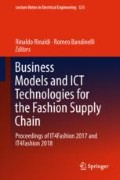Abstract
Companies working in fashion retail require scientific methods to transform the enormous amounts of data they collect into information that can be useful to predict future sales. Literature has presented a huge number of statistical/data-science based techniques, able to perform forecasting of time series, like the number of pieces—belonging to a certain brand or category—sold in retail stores. This paper aims to put together some of these methods to build a robust meta-model able to better understand the hidden relationships between data. Classical and more recent methods to compute a category level forecast are shown, giving particular attention to the modeling of price effect. Finally, we show that the use of a metamodel helps reducing the forecasting error on the yearly category forecast by 24%.
Access this chapter
Tax calculation will be finalised at checkout
Purchases are for personal use only
References
Box, G. E. P., & Jenkins, G. (1990). Time series analysis: Forecasting and control. Holden-Day.
Choi, T.-M., Hui, C.-L., & Yu, Y. (2014). Intelligent fashion forecasting systems: Models and applications. Springer.
Hyndman, R. J., & Athanasopoulos, G. (2014). Forecasting: Principles and practice. https://www.otexts.org/book/fpp.
Hyndman, R. J., & Koehler, A. B. (2006). Another look at measures of forecast accuracy. International Journal of Forecasting, 22(4), 679–688.
Taylor, S., & Letham, B. (2017). Forecasting at scale. https://research.fb.com/prophet-forecasting-at-scale/.
Thomassey, S. (2010). Sales forecasts in clothing industry: The key success factor of the supply chain management. International Journal of Production Economics, 128, 470–483.
Thomassey, S., & Happiette, M. (2007). A neural clustering and classification system for sales forecasting of new apparel items. Applied Soft Computing, 7, 1177–1187.
Zhang, G. P. (2003). Time series forecasting using a hybrid arima and neural network model. Neurocomputing, 50, 159–175.
Author information
Authors and Affiliations
Corresponding author
Editor information
Editors and Affiliations
Appendix: Main Forecast Error Measurements
Appendix: Main Forecast Error Measurements
Observed value of the i-th time series at time t: \(Y_{i,t}\).
Predicted value of the i-th time series at time t: \(F_{i,t}\) .
Error of the single observation: \(e_{i,t} = Y_{i,t} - F_{i,t}\).
Mean absolute error: \(MAE_i=\sum _{t} |e_{i,t}|/n_i\). Scale dependent.
Percentage error: \(p_{i,t}=(Y_{i,t}-F_{i,t})/Y_{i,t}\). Requires \(Y_{i,t}\ne 0\).
Mean absolute percentage error: \(MAPE_i=\sum _{t} |p_{i,t}|/n_i\). Sensitive to \(Y_{i,t}\approx 0\).
Relative error between forecasts \(F_{i,t}\) and \(F_{i,t}^b\) (benchmark): \(RE_{i,t}=e_{i,t}/e^b_{i,t}\).
Benchmark-scaled error: \(q_{i,t}=e_{i,t}/MAE_i^b\).
Mean absolute scaled error: \(r_i=\sum _{t} |q_{i,t}|/n_i= MAE_i/MAE^b_i\).
Average Relative MAE: \(AvgRelMAE= \Big (\prod \nolimits _{i=1}^m r_i^{n_i}\Big )^{\frac{1}{\sum _{i=1}^m n_i}}\). Geometric mean of MAEs.
\(AvgRelMAE<1 \Leftrightarrow MAE^a_i < MAE^b_i \Leftrightarrow \) Model A is more accurate than model B.
Rights and permissions
Copyright information
© 2019 Springer Nature Switzerland AG
About this paper
Cite this paper
Armando, E., Craparotta, G. (2019). A Meta-Model for Fashion Retail Category Sales Forecasting. In: Rinaldi, R., Bandinelli, R. (eds) Business Models and ICT Technologies for the Fashion Supply Chain. IT4Fashion 2017. Lecture Notes in Electrical Engineering, vol 525. Springer, Cham. https://doi.org/10.1007/978-3-319-98038-6_7
Download citation
DOI: https://doi.org/10.1007/978-3-319-98038-6_7
Published:
Publisher Name: Springer, Cham
Print ISBN: 978-3-319-98037-9
Online ISBN: 978-3-319-98038-6
eBook Packages: EngineeringEngineering (R0)

